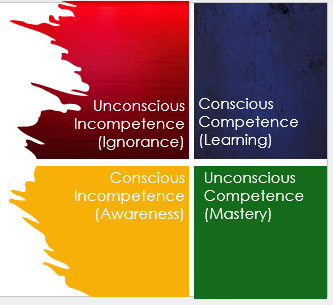The Four Levels of Competence was initially by Martin Broadwell in the 1960s. The first mention of the Four Levels of Competence was noted in an article entitled, “Teaching for Learning” in 1969. Based upon this initial work, Noel Burch further developed this theory renaming it as the Four Phases of Learning New Skills.

Within this framework, an individual moves through four stages of learning, growing from an ignorance to mastery. Each stage or level focuses on the mastery of learning. Ignorance. Awareness. Learning. Mastery. The best part of this theory is the simplicity and ease in using – especially when looking at OJT (on the job training) or apprenticeships.
Unconscious Incompetence (Ignorance)
At this beginning phase, the individual is simply unaware that the concept or information even exists. Ignorance does NOT refer to the individual being ignorant. It does refer to the individual not knowing that the topic or information even exists.
Conscious Incompetence (Awareness)
The individual may have been introduced to a new concept, but they do not fully understand the information or the concept. The individual lacks proficiency in this new area.
Conscious Competence (Learning)
The new skill is now being used, but it is being used with effort. The learner is trying on the new skills but may not be able to make it function fluidly.
Unconscious Competence (Mastery)
The new skill is automatic. Simple. Takes little effort.
Example:
My favorite example of this theory in practice is driving. Ignorance – As a child you don’t even realize all of the different skills needed to drive a car. You get in the car. A licensed individual drives you where you needed to go.
Awareness – The new driver starts to observer the instructor. Maybe the new driver is reading the driver’s manual. They are preparing to take their exam.
Learning – The new driver is behind the wheel. They suddenly recognize the need to pay attention to the three (or more) mirrors on the vehicle. They start to synchronize the turn signal, looking for oncoming traffic, etc. They will notice the varying skills and techniques to driving.
Mastery – As an experienced driver, the individual does not even realize they have used the turn signal, checked for oncoming traffic and smoothly made the turn.
Currently, I work in training within food manufacturing. I enjoy watching new associates walking onto our floors and learning the rules for safe food. One of these aspects is the use of the hairnets. When associates first come into the facility, they are guided to the containers that hold the varying colors of hair nets. (The different colors of hair nets indicate the varying jobs on the floor.) Many didn’t even realize that hair nets are needed and required. Let alone a different color for a different job. (Ignorance)
Associates realize that hair nets are required. They learn the color they will need to use for their position. (Awareness)
Next, they will start to learn how to properly wear the hair net. They may use the mirrors that are available to them. Sometimes, they will ask for verification from someone around them to let them know if they were wearing the hair net correctly. Did they have the right color? Was all of their hair tucked inside? (Learning)
(Mastery) After associates have been using the hair nets for some time, they will fluidly use them. It is fascinating to watch this transformation. The associate will walk by the container, grab a hair net with little thought and quickly slip the hair net on. Sometimes, associates may even be talking and laughing with another associate while slipping the hair net on. Mastery.
Take a moment to think about how the Levels of Competence can be used. What examples can you think of?
Broadwell, M. M. (1969). Teaching For Learning (XVI.), in The Gospel Guardian, Vol 20, No 41, 1969,

Comments are closed